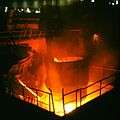Mittal Steel Company
 | |
| Public | |
| Industry | Steel |
| Successor | ArcelorMittal |
| Founded | 1989 as Ispat International in Sumatra, Indonesia |
| Defunct | Merged (2006) |
| Headquarters | Rotterdam, Netherlands |
Key people | Lakshmi Mittal, founder, chairman and CEO |
| Products | Steel, flat steel products, coated steel, tubes and pipes |
| Revenue |
|
|
| |
|
| |
Number of employees | 320,000 (2006) |
| Website |
www |
Mittal Steel Company N.V. was one of the world's largest steel producers by volume, and also one of the largest in turnover. The company is now part of ArcelorMittal.[1]
CEO Lakshmi Mittal's family owned 88% of the company. Mittal Steel was based in Rotterdam but managed from London by Mittal and his son Aditya. It was formed when Ispat International N.V. acquired LNM Holdings N.V. (both were already controlled by Lakshmi Mittal) and merged with International Steel Group Inc. (the remnants of Bethlehem Steel, Republic Steel and LTV Steel) in 2004. On 25 June 2006, Mittal Steel decided to take over Arcelor, with the new company to be called ArcelorMittal. The takeover has been successfully approved by shareholders and directors of Arcelor making L.N. Mittal the largest steel maker in the world.
History
It was formed as Ispat International in 1978, at the time it was part of the Indian Steel making company Ispat Industries which was founded by Lakshmi Mittal's father and was owned by his family, but in 1995 it separated from that company after various disagreements between Lakshmi and his father.
In 1989, the company acquired Iron & Steel Company of Trinidad & Tobago. In 1992, the company acquired Sibalsa. In 1994, the company acquired Sidbec-Dosco. In 1995, the company acquired Hamburger Stahlwerke, which formed Ispat International Ltd. and Ispat Shipping, and also bought Karmet Steel of Temirtau, Kazakhstan. In 1997, the company acquired Walzdraht Hochfeld GmbH and Stahlwerk Ruhrort. In 1997, the company went public as Ispat International NV. In 1998, the company acquired Inland Steel Company. In 1999, the company acquired Unimétal. In 2001, the company acquired ALFASID and Sidex. In 2002, it bought a majority stake in Iscor. In 2003, the company acquired Nowa Huta.
In 2004, the company acquired Polskie Huty Stali, BH Steel, and certain Macedonian facilities from Balkan Steel. In 2005, the company hired Deloitte as the primary auditors for the company. In 2005, the company acquired International Steel Group. In 2005, the company acquired Kryvorizhstal. In 2005, the company announced the investment of $9 billion in Jharkhand, India. In 2006, the company merged with Arcelor after much controversy. In 2006, the company announced investment for a 12 million tonne capacity steel plant in Odisha, India.
Bids and acquisitions
In October 2005 Mittal Steel acquired Ukrainian steel manufacturer Kryvorizhstal for $4.8 billion in an auction after a controversial earlier sale for a much lower price to a consortium including the son-in-law of ex-President Leonid Kuchma was cancelled by the incoming government of President Viktor Yushchenko.
In 2005 Lakshmi Mittal flew into Jharkhand, India to announce a $9 billion investment to build a greenfield steel plant with a 12 million tonnes per annum production capacity.
On 27 January 2006 it announced a $23.3 billion (€18.6 billion, £12.7 billion) bid for Arcelor. On 19 May 2006 Mittal increased its offer for Arcelor by 38.7% to $32.4bn, or $47.34 per share (€25.8bn, €37.74 per share). On 25 June 2006 Arcelor, in a board meeting announced that it has accepted a further sweetened offer ($50.68 or €40.4 per share) and the new company would now be called ArcelorMittal, thus successfully ending one of the most controversial and publicised takeover bids in modern corporate history. ArcelorMittal is now by far the largest steelmaker in the world by turnover as well as volume, controlling 10% of the total world steel output.
